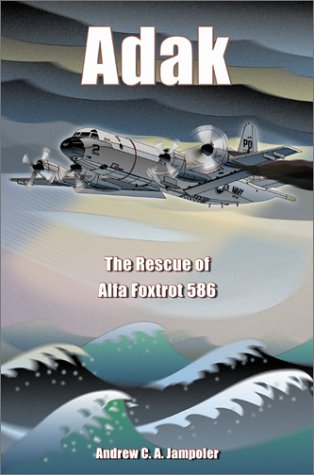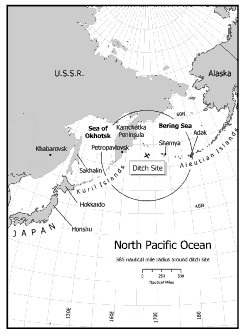The Rescue of Alfa Foxtrot 586 |
||

|
Andrew C.A. Jampoler Naval Institute Press Annapolis, Maryland ISBN: 1 59114 412 4 |

|
The Rescue of Alfa Foxtrot 586 |
||

|
Andrew C.A. Jampoler Naval Institute Press Annapolis, Maryland ISBN: 1 59114 412 4 |

|
Mid-afternoon October 26, 1978, "Alfa Foxtrot 586," a US Navy patrol aircraft flying from Naval Station Adak, in the Aleutian Islands, ditched at sea with fifteen men aboard. The four engine aircraft hit the water and sank almost immediately under huge waves spun up by a storm in the western Bering Sea.
AF 586 had been flying a sensitive reconnaissance mis-sion off the Soviet Kamchatka coast, above the usually vacant waters of this corner of the North Pacific, when a propeller malfunction followed by a succession of engine fires forced the ditching.
During the last ninety minutes of the flight, Crew 6's pilots had tried to nurse their aircraft hundreds of miles to the nearest American airfield, on Shemya Island. Meanwhile, in the cabin, the rest of the crew coolly terminated their mission, des-troyed crypto equipment, and prepared themselves for the coming ordeal.
After the second fire in the number 1 engine, AF 586's fire extinguishers were spent. A third blew itself out. The fourth threatened to burn through the wing.
AF 586 finally splashed into thirty-foot seas almost exactly midway between the U.S. and the U.S.S.R., twenty-five years into a cold war that defined U.S.-Soviet relations as a zero sum game.
In the dark, flooded cabin, the crew managed to launch two of the three rafts on board, but all the other emergency equipment sank with the aircraft. The off-duty flight engineer, Butch Miller, went down with the aircraft, unconscious or already dead and probably still belted into his seat in the galley. The plane commander, Jerry Grigsby, was the last man into the water. Swimming desperately, he failed to reach either of the rafts, despite the other survivors' efforts to paddle one to him.
Crew 6's three sensor operators died of exposure during a terrible night spent hip-deep in cold water, in a swamped, overloaded raft buffeted by powerful winds and snow squalls. The three, Rich Garcia, Jim Brooner and Randy Rodriguez, were the youngest men aboard. (The fact that only the three youngest enlisted men on the crew died in the rafts raised questions that reverberated during the accident investigations that followed the loss.) All the others were very close to death by early the next morning.
When AF 586 went in, the nearest US Coast Guard ship was days away, separated from the rafts by a winter tempest that would churn up fifty-foot waves in the Bering Sea.
An Air Force special mission aircraft, diverted from its high priority flight collecting intelligence on Soviet missile tests, first spotted the rafts. Navy and Coast Guard search and rescue aircraft from Alaska quickly closed on the scene, but SAR operations would soon be grounded by high winds progressively closing Aleutian airfields as bad weather blew southeast down the chain. A Russian fishing trawler, on the way home to Sakhalin Island until sent to the site following an urgent appeal from Washington to Moscow for assistance, was the crew's only hope.
The trawler, led to the scene by a US Coast Guard aircraft dropping flares onto the roiled surface of the ocean, arrived there just as Jim Brooner died.
ADAK is the exciting true story of this mission, written by a navy aviator who has flown the same model aircraft on the same mission from the same Aleutian base. His authentic account is drawn from extensive interviews with survivors, with the master of the Soviet trawler and with many of the crewmen in the search and rescue aircraft that flew overhead the rafts October 26-27. These personal recollections have been augmented by information from official navy investigations, communications between Washington and Moscow, and the recorded radio exchange between AF 586 and the ground as the emergency progressed.
ADAK will appeal to any reader of sea survival stories, true adventure, or military and aviation history.
Return to ADAK website